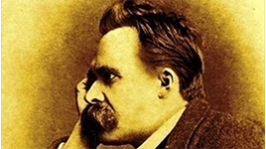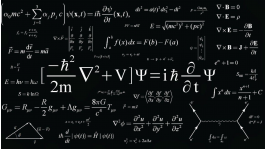The Theory of the Eternal Return: plagiarism or original?
The Theory of the Eternal Return or the Myth of the Eternal Return in Nietzsche’s creation presents one of the most sophisticated, contradicting and mostly criticized philosophical conceptions. At the same time, it is one of the deepest ideas, which gains its beauty, logics and harmony with the consolidation of Nietzsche’s Over-man study.
The controversial attitude to the Theory of the Eternal Return is supported by several circumstances. For instance, Nietzsche is often neglected in his novelty and originality concerning the similarity between his ideas and Heraclitus’s philosophy. Indeed, according to Heraclitus, 1. Fire is the primary source of everything; some find this idea in its figurative sense as the energy which is the primary basis of the creation of the world; 2. World and space periodically burn down in a powerful fire, in order to restore again; 3. Everything is being in an eternal circle, which reflects Heraclitus’s aphorism “Everything flows and everything changes”; 4. The Law of Opposites (Rain, 2016). Even though Heraclitus’s studies have reached us in some fragmentary form, we can courageously conclude that it is not the equivalent to Nietzsche’s theory, who speculates not only about the abstract circles but about the fact that our world has already precisely existed, and it will definitely reborn identically in future as it is now. In other words, we estimate the identity of the present, past and future worlds in their precise details. The contradiction of Nietzsche’s and Heraclitus’s ideas is completely represented in Heraclitus’s aphorism: “No one can enter the same river twice”. Thus he strongly neglects the trivial circle of events.
If we only have a brief look at the antiquity, we can assume that Nietzsche’s study is much closer to Solomon’s philosophical doctrine, which is depicted in the Book of the Ecclesiastes of the Old Testament: “Humanity passes, humanity comes, and the Earth is eternal. The sun rises, the sun sets, and it rushes to its place where it rises. The wind comes to the south and reaches the north, it spins and spins on its circle, and the wind falls back into its place. All the rivers flow into seas, but seas don’t overfill: they return to the place where they come from in order to flow again… What was there - will be, what was being done - will be being done, and there is nothing new under the sun… There is something about which they say: “Look! This is the new”; but this was centuries ago before us” (The Bible, 1992, p. 618). However, the main Solomon’s idea is in worldliness, and the fact of cycling serves as a proof and illustration of person’s aspirations. But it does not transform his evident idea of cycling in his philosophy. At the same time, Solomon speaks about the circle of events as a whole, which can be estimated as the model of the observing events and of its nature, not about its precise copying at all.
Thereby, Nietzsche had his predecessors, but this fact does not except the originality of his Theory of the Eternal Return. However, a reservation should be made, even admitting the championship concerning Nietzsche’s Theory of the Eternal Return, we cannot solve the problem of its truthfulness.
Premises to the creation of the Theory of the Eternal Return
The Theory of the Eternal return had its original backstory. We can highlight two triggers here – Charles Darwin’s Evolution Theory and Eugen Duhring’s Theory of Combinations. According to James H. Berks, the Darwin awoke him from his dogmatic dream, making him realize that during the whole period of the organic world neither of the species have remained unchangeable (Berks, 2000). Replacing eternal stillness, there come the comprehensive modifications. Nietzsche reacted painfully on Darwin’s Evolution Theory, which means according to him, the collapse of all the traditional beliefs and values, as far as the material world in it has lost its spiritual aim. And if it is so, then no constant morality there can be. Nietzsche could not accept this thesis. He considered that the idea of the endless progress has a lineal nature. Whereas the study of recurrence is not only more ancient, but as a direct result is being supported by our each step: plants, animals and human beings return in generations, movements of the stars, seasons and seas are also being recurred. Any periodicity supposes its return (Junger, 2001).
The second intellectual trigger Nietzsche got from Duhring, who had postulated the idea of the fact that our Universe can occur to be a combination of some very elementary particles. In turn, it directed to the idea that the whole general world process is considered to be some range of varieties of the particles’ combinations, which has its limit.
Endless reconstructions of the system must obviously lead to the creation of such Universe, which would be identical to the one that took place before. In other words, the world process is no more than a cyclic revision of what has already happened once (Frolova, 2019). Afterwards, Duhring rejected his idea, but it had astonished Nietzsche so much that he equipped himself with this theory and led it to the logical ending.
The Theory of the Eternal Return and the idea of the Over-man: the Great Synthesis
Adapting Duhring’s idea, Nietzsche resumed that the basis of the being is the limited quantity of the physical energy quanta, which are equivalent to the biological quanta of power. These elements are in constant contention in relation to each other, and as a direct result, there come their separate combinations. And concerning the fact that the quantity of quanta is a constant value, from time to time there must arise some combinations which took place in the past. Thereby, here comes the idea of the Eternal Return of the same events, which is the essence of the Theory of the Eternal return (Frolova, 2019). The new study gives the existence of the humanity an image of space sound, and it does not require the presence of God (Berks, 2000).
In parapraph 241 “Joyful Science” the Theory of the Eternal Return gets some social arrangement, where Nietzsche acts out an imaginary situation in which a demon sneaks up to a person and opens the horrifying mystery of the being: “This life, which you live now and have lived, you will have to live again and endless times again; and nothing will be new in it, but each pain and each pleasure, every thought and every sigh of yours, and anything tiny or great in your life will have to return to you, in the same order and in the same sequence…” (Nietzsche, 2000, p. 660). And, in Nietzsche’s opinion, each person must answer the sacred question: ”Do you really want it to happen again and endless times again?” (Nietzsche, 2000, p. 660).
The considered Nietzsche’s concept evidently supposes some a priori and interconnected assumptions: 1. Total sum of energy or power in our Universe is finite; 2. The whole energy remains eternal constant; 3. Quantity of the energy state is finite; 4. Space is finite, in spite the fact that time is endless, cyclic and irreversible; 5. Modification is eternal; 6. The appearance of the sensible creatures can be understood not referring to religion (Berks, 2000). Consolidation of the presented predicates allows us to receive a self-consistent theory of the Eternal Return. We shall temporally leave the discussing of the ancient postulates and ask a question: What does the Theory of the Eternal Return promise a particular person?
We must admit that if we do not respond to the stated question, the Theory of the Eternal Return does not make any value as much as in a philosophical sense. In fact, for Nietzsche it acts as the provocative doctrine, which demands a serious addition. And as such an addition, there appears the study of an Over-man Theory, which is given in a composition that is called “That is how Zarathustra spoke”. But first, he concentrates on his idea of return, which Zarathustra discusses with a dwarf who represents a sacred thought: “Everything straight lies. Any truth is a curve but the time itself is a circle” (Nietzsche, 1990b, p.112). And in that dialogue Zarathustra asks the main questions: “Mustn’t everything that can go have already passed this way? Mustn’t everything that can happen has already happened and gone?” (Nietzsche, 1990b, p. 112). And afterwards he interests: “Are the things connected as tightly as this Moment attracts everything coming? Consequently – as well as itself does? For everything that can go must pass this long way once again straight ahead!” (Nietzsche, 1990b, p. 113). Thus, having got himself in a tight corner with those questions, Nietzsche represents a term - Over-man. More and foremost, there goes a quintessence of his study: “Human is something that must overcome”; “Human is a bridge but not an aim” (Nietzsche, 1990b, p. 142).
Nietzsche supposed that Darwin’s Theory of Evolution can explain only the success of the lowest (the weakest and the most unreasonable!) life forms such as viruses, bacteria, insects and fish. However, the quantity of the organisms does not replace the quality of particular species. Therefore, Darwin’s interspecific fight of masses for their existence must be replaced to the individual fight of the very few for their predominance, self-perfection and supremacy. The philosopher reasonably accepted the presence of the natural tendency of the human species to evolve towards general mediocrity. But, concerning the will of power, the supreme individuals attain abilities to control their lives, to overcome nihilism and pessimism, develop their intelligence and activate creativity. Therefore, considering evolution as a progress of a human, Nietzsche appreciated creative individuals rather than mediocre masses. Society is not the aim of evolution, but the transformation of the particular subject into an Over-man. Nevertheless, according to Fariman Guliev, Nietzsche has not got straight definitions of an Over-man (Guliev, 2016).
What is Over-man then? It is Nietzsche’s image, metaphor and heuristic of his. It is rather complicated to depict his portrait, as far as we have never seen him, moreover, we cannot realize the inner world of the creature which exceeds us spiritually and intelligently. But Nietzsche has no doubt in existence or in possibility of appearance of the Over-man at least. Therefore, the philosopher is trying to characterize a new phenomenon indirectly. And the logic in this theory is quite simple: as a monkey overcomes a human, an Over-man overcomes a human. Here comes the famous Nietzsche’s metaphor: human is a rope between an animal and an Over-man.
The German philosopher did not see any particular differences that made a human and some large monkeys, and thereby he claimed that some individuals will rise higher than animals, including our species, but these supreme creatures will appear in future as a result of not a biological but a psychological evolution. In terms of development, Over-man is a dignified but unbelievable creature of the future, which will overcome a present human as much as our species overcome lower worms! (Berks, 2000).
To our way of thinking, the discovery of the fact that a human is not a crown of nature, but only some transition state from an animal to an Over-man, is the greatest achievement of the German philosopher.
Friedrich Junger fairly states a question: What do we need an Over-man for? Loving people do not want to be different at all and they are more than self-sufficient for themselves. Isn’t the fact of recognition of a person is an act of love as it is and one’s being? But for Nietzsche the problem is stated in another way: there is something in a human that aims to exit and points at one’s limits. There is something that he is trying to overcome, destroy and ruin (Junger, 2001, p. 195). As a result, a human has an intention to overcome oneself and one’s biological species. And here, in this logical knot, appears a great crossroad for a common person and an Over-man.
Friedrich Nietzsche realized clearly that the Universe is absolutely indifferent to human existence. However, his idea of the Over-man offers an optimistic breakthrough for those creative personalities who wish to follow heroic ideas (Berks, 2000). An Over-man does not fear the Eternal Return. An Over-man possesses the courage which kills even death, and says: ”What was life like? So what? Let’s try again!” (Nietzsche, 1990b, p. 112). As a triumph of an Over-man, Nietzsche uses an allegorical story about a shepherd in whose throat a snake got; a snake is a symbol of everything hardest and blackest in life. In that scene the shepherd bit off the snake’s head, as Zarathustra advised him to, spilt it far away, got on his feet and laughed his head off. But the one that laughed was a new, transformed and enlightened creature. “Never on earth, a man laughed the way he laughed!” “A desire of that kind of laughter is devouring me…” (Nietzsche, 1990b, p. 114).
Thereby, an Over-man overcomes his Eternal Return. And what is left to common people? Their awareness of the Eternal Return lies hard on their actions (Nietzsche, 1990f, p. 660). Recognition of the fact that there is no God at all leads to the idea that a person’s life makes no sense or aim, and loneliness becomes irresistible. But even in this occasion, not everything is lost. For mediocre people, their aim and meaning of life must be the Over-man, the desire and intention to become this kind of man (Junger, 2001, p. 207).
To sum up, paradoxically, the myth of the Eternal Return and the idea of the Over-man are supposed a rather optimistic dichotomy: a strong and exceptional personality acts perfectly and becomes an Over-man. Hence, any return of this creature gives the return of one’s creative actions and the extasy in life; the mediocre individuals will get not God but an Over-man instead, and will have to work hard to reach this ideal, hence the Universe gives endless chances to transform then.
The Theory of the Eternal Return and Quantum Physics
The idea of the Over-man is not only rational enough but can be even considered as empirically based. It is quite obvious to see that Nietzsche’s aphorism that human is a bridge between a man and an animal was soon repeated with a little arrangement by Carl Gustav Jung: human is an animal which has gone mad; there are two ways out of that madness: it must either become an animal again or become something greater than a human. The whole oriental tradition – yoga, Hinduism or Buddhism – follows the idea to develop one’s conscious till its total transcending (enlightenment), when it accommodates the whole Universe. No doubt that individual with such a consciousness can be considered as an Over-man (who was Buddha, for instance); as a rule, those kind of people possess some sorts of supernatural abilities. In addition, all these concepts are based on the recognition of the fact of reincarnation (reborn of souls), and the process of the return of the soul onto the earth life is called a samsara wheel (Leontyeva, 2019). Moreover, there is no term of God in Buddhism, as far as God according to its definition is an endless creature which cannot be defined in terms of finite logic. Following this idea, the question of God’s existence does not make sense, because it seems completely impossible to answer it correctly in any acceptable way, and it only arises all the intelligent gambling on this point (Govinda, 1993, p. 42). However, neither of the oriental religious studies supposes any return of the soul with its further exact reiteration of some or other previous life. In this sense, Nietzsche’s theory about Eternal Return is some unique abstract extremeness. Arthur Danto tried to “save” the German philosopher’s theory explaining what he had meant, that all the specific and particular things return constantly again and again - exactly all those very things but not their similarities (Danto, 2001). And if so, this is about a complete copy of a human as far as the original died and disappeared long ago.
Nevertheless, while arranging the myth about the Eternal Return, Nietzsche built it on some fact which was based on quantum physics. In fact, he supposed that the quantity of all elementary particles (atoms) in the world is finite and the quantity of their combinations as well. Unfortunately, this idea does not resist critic. First, accurate calculations of the particles’ quantity in the Universe are impossible as far as the accurate size of it is unknown. Therefore, only some approximate value of that subject can be made. Second, even those approximate calculations of the helium atoms’ particles give a quantity of 1082 (Savelyev, 2018), which is beyond consideration and represents a typical case of wrong infinity according to G. Hegel. If we try to count a number of possible combinations between those atoms, it will show that a possibility of total renewals of human lives equals zero. It reminds us a classical exercise on identifying a possibility, where a monkey accidently hitting a typewriter can type Shakespeare’s original “Hamlet” lyrics. Calculations show that a possibility of an accidental typing a text from a famous poem is astronomically little and it equals 1/(3,4 . 10183946). It is as little as the whole existence of our Universe will not be enough to realize this event (“Teorema…”, 2020).
Obviously, modern quantum cosmology states that the time of existence of our Universe is not infinite on the other hand, space is not limited at all. Therefore, Nietzsche’s postulates do not match modern scientific statements, and the theory of Eternal Return is without validity. Nevertheless, there are still some attempts to save Nietzsche’s theory. For example, professor of physics Paul Steinhardt from Princeton University assumes that the German philosopher’s speculations on nature can have a scientific ground (Steinhardt, 2014). Although all the considered cosmological models only justify the fact that some recurrence is really specific for the Universe, but not of any complete repeatability can be spoken about.
Thus, in his theory Nietzsche tried to support his ideas with quantum physics, but that is where all his postulates contradict it. On the other hand, as far as we can see, there is a peculiar analogy with the initial point of quantum physics. According to the wave-particle duality, the photon of light is both a particle and a wave at the same time, depending on the way of observation. It is one of the most incomprehensible attributes in modern physics. In a similar way a person carries a mediocre-extraordinary dualism, if it is possible to say: some people still remain mediocre at the level of their primitive being not far away from animals, others are capable to reach the level of an Over-man. Exactly this dualism – Mediocre/Over-man predicts a place of an individual in a circle of an eternal return.
The Eternal Return, an Over-man and the Paganism
At first sight it seems that Nietzsche, having expelled God from his worldview, in his theory of the Eternal Return made a step back to the Paganism by praising other creatures. However, this statement can hardly be justified. Nietzsche’s logic approximately follows this way.
As far as there is no any God, no any existential loneliness can be stood then. In this occasion the work must be done by a super human. What kind of work is it? First and foremost, it must be the destruction of the idols’ world – any idols and any authorities. An Over-man appears when a common man loses one’s sense. But as for the Paganism, idolatry and all sorts of deification of various idols is quite characteristic. Hence, an Over-man is against all forms of Paganism, an Over-man does not worship anything. Therefore, Nietzsche’s concept is not one of the kinds of religious doctrines; it is represented as a pure form of atheism. All Gods and idols are replaced with a live energy and willpower. These phenomena are the foundation of any creation and have an enduring self-value.
To sum up, what is the role of the Eternal Return and Over-man theories? The way we see it, not insisting on truth of judgment, it seems to be beautiful, and the aesthetic satisfaction is valuable itself. Moreover, the main message of the theory looks rather reasonable and fair: we should live our lives the way not to fear, regret or feel sad to experience this life once again.
References
Бёркс X.Д. (2000). Ницше, эволюция и вечное возвращение// «Здравый смысл», №3(19). http://www.nietzsche.ru/look/xxc/ontologie/berks/
Библия. Книги священного писания Ветхого и Нового завета. (1992). М.: Издательство Московской патриархии. – 1372 с.
Говинда А. (1993). Психология раннего буддизма. Основы тибетского мистицизма. С.-Пб.: Андреев и сыновья. – 470 с.
Гулиев Ф. (2016). В чем суть идеи «сверхчеловека» Фридриха Ницше/ Яндекс-Кью, 26.04.2016. https://yandex.ru/q/question/v_chem_sut_idei_sverkhcheloveka_fridrikha_c0273dce/
Данто А. (2001). Ницше как философ. М.: Идея-Пресс. – 280 с. http://www.nietzsche.ru/look/xxb/danto/
Леонтьева Е. (2019). Путеводитель по буддизму: иллюстрированная энциклопедия. М.: Эксмо. – 256 с.
Ницше Ф. (1990а). Сочинения в 2 т. Т. 1. М.: Мысль. – 832 с.
Ницше Ф. (1990б). Сочинения в 2 т. Т. 2. М.: Мысль. – 830 с.
Раин Е. (2016). Гераклит: философия, основные идеи, высказывания/ FB.ru, 17.01.2016: https://fb.ru/article/224814/geraklit-filosofiya-osnovnyie-idei-vyiskazyivaniya
Савельев В. (2018). Интересное о космосе: теория Большого взрыва и количество атомов во Вселенной/ FB.ru, 23.06.2018: https://fb.ru/article/396516/interesnoe-o-kosmose-teoriya-bolshogo-vzryiva-i-kolichestvo-atomov-vo-vselennoy
Стейнхардт П. (2014). Вселенная по Ницше: современная космология и теория вечного возвращения/ ИНОСМИ.РУ, 18.07.2014: https://inosmi.ru/world/20140718/221704606.html
Теорема о бесконечных обезьянах (2020)/ Википедия, 11.05.2020: https://ru.wikipedia.org/wiki/Теорема_о_бесконечных_обезьянах
Фролова Л. (2019). Ницше. Вечное возвращение: философские идеи, анализ, обоснования/ FB.ru, 12.01.2019: https://fb.ru/article/456963/nitsshe-vechnoe-vozvraschenie-filosofskie-idei-analiz-obosnovaniya
Юнгер Ф.Г. (2001). Ницше. М.: Праксис, 2001. – 256 с.
Translation in English: M.S.Bazenkova
Official link to the article:
Balatsky Y.V. Nietzsche’s Theory of the Eternal Return and Quantum Physics// «Non-ergodic economy», 12.06.2020.









